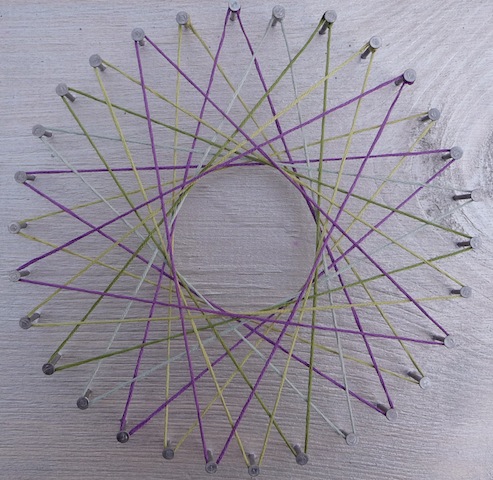String art seems to have made a comeback. It began life as a teaching tool for math in the mid 1800’s, and became a popular craft in the 60’s and 70’s. Its long period of dormancy has finally come to an end, and it remains a wonderfully creative way to explore geometric patterns with older kids, and unique random designs with younger ones. We had great results experimenting with both.
Materials
- wood
- sand paper
- paint and brush
- paper
- scissors
- compass
- protractor
- ruler
- pencil and eraser
- tape
- hammer
- nails
- pliers
- scissors
- string/yarn/embroidery thread
- white glue
Instructions
1. Wood makes the perfect base for this project, and small pieces are easy to come by in hardware stores. They can be found in scrap sections, or even in garbage cans. I’m not a dumpster diver, although it’s going to sound like I am, but I happened to walk past the garbage can near the big saw at Home depot, and there they were…perfect little pieces of wood calling out to me, and free no less. How you wish to acquire your wood is definitely up to you, but once you get it home, sand any rough edges, and paint it in a colour that will work well with the string/yarn/embroidery thread you will be using. Allow to dry.
2. I found an interesting, not too difficult pattern made with 6 different coloured pentagrams. Making the design will give older children an opportunity to practice a little math by dividing the circle into sections. To do this, take a white piece of paper and make a circle using a compass. Make sure the size will fit nicely on the piece of wood you’re using.
With a ruler, draw a straight line across the circle, making sure it goes through the centre. Place a protractor along the line at the centre, and divide that half into 3 equal parts. Do the same for the other half. Since a circle is 360 degrees, and half the circle is 180 degrees, each section should be 60 degrees.
Next, use the protractor to divide each 60 degree section into 5 sections (12 degrees each). Do that for the entire circle. You will now have a circle with 30 marks indicating where each nail should go.
3. Trim the paper if necessary, and tape to the wood. Place something under the wood to protect the surface you’re working on, just in case the nails are hammered through the bottom. Hammer a nail on each of the marks you’ve made along the circumference of the circle. Each nail should be deep enough so the string can be pulled around it tightly without moving it. And make sure the nail has a head on it, so the thread is held in place.
Once all the nails have been hammered in, lift the paper up and tear it away. Use pliers to straighten any nails that may be on an angle. Finally, if you want to colour the heads of the nails, now would be a good time to add a little acrylic paint or nail polish. Allow to dry.
4. Time to add the string, yarn or embroidery thread. Tie thread around one of the nails. Don’t trim the thread too close or it will come undone. Glue will be added later to hide the thread. Moving clockwise, wrap the thread 12 nails away from the first one, and continue doing this, with 12 nails in between each one you wrap around, until you get back to the first nail. Tie a knot to complete the pentagram.
Choose another thread colour, and repeat the process beginning on the nail beside it. Continue until all the pentagrams have been made. Add a little white glue with your fingers to clean up the knots you have made, so the thread ends don’t show.
For younger children, an adult can either prepare the pattern for them, or provide the option of randomly hammering nails on the wood, and working from there. The results were just as fun.
Here are some cool examples of string art:






















































I remember doing those in school. Since it was for math, the string was boring white. Lots of possibilities when you have a variety of colors available!
You’re right! I also remember doing this in school, although I have no idea what we made.
This is great, I think I will try it!
Thanks Tina! It’s really easy to make, and I’m sure you’ll enjoy it 🙂
Love the vibrant colors! I’m gonna have to try this. 🙂
Thank you for partying with the Wildly Original Crowd.
❤ Christina at I Gotta Create!
This has definitely gone on out things-to-do-list. Thanks for sharing!
oops – ‘our’ not ‘out’. Sorry. :o)
Thanks Susan! Hope you have fun making it 🙂
This is a super cool craft…love it! Thanks for sharing it at our Sunday Show and Tell!
I remember doing these at school – can’t wait to try them again with my girls! Thanks for the inspiration for our long school holidays which have just begun!
Thanks for linking to a Round Tuit!
Hope you have a fabulous weekend!
Jill @ Creating my way to Success
http://www.jembellish.blogspot.com/
Wow, I’m amazed by the number of people who have done this in school! Have fun with your girls.
Pingback: Sunday Show and Tell! (Week 11- Plus Featured from Week 10) | Two Kids Cooking and More
What a fun craft! I love the colors. Thanks so much for the inspiration, and for sharing at A Bouquet of Talent!!
WOW. I didn’t know the history behind this re-emerged trend. I found your description fascinating. The pieces you created are beautiful.
Thank you so much! I was also surprised its use in the classroom went back to the 1800’s.
Very pretty! Pinning for when my kids get a little older!
Thank you!
What a beautiful work of art! So clever!
Just wanted to let you know I featured you at TGIF this week: http://www.livinglifeintentionally.blogspot.com/2012/11/tgif-linky-party-56.html
Thanks for linking up & have a GREAT weekend,
Beth =-)
Thanks beth. I really appreciate it! Hope you also have a great weekend!
Oh, how fun and beautiful! Reminds me of straight line art I use to do in geometry classes. Thank you for sharing at Sharing Saturday! And, congratulations on being the most clicked this week!
Definitely the sort of project that takes us back to math class! Thanks so much for letting me know, and for hosting 🙂
I love string art, there’s so many says to use it! Yours looks awsome, and what an amazing blog you have, thank you so much for a comment on my blog, have a happy and merry holiday!
Thank you so much! Hope you also have a wonderful holiday season 🙂
Looks really cool. Have you checked out Peruvian string earrings? It’s string art jewelry! I want to try making some.
I just had a look. They remind me of peacock feathers. Very cool! Thanks so much for the telling me about them 🙂
You can make a string art project from the shape of a state.
Maybe your home state with the city used in the design of the string.
Check it out on the internet. There are lots of ideas out there
Pingback: {Fun} Kids Craft Ideas - Kids Activities Blog
Pingback: 20 Blogs Reviving the Lost Craft of String Art | Babysitting Jobs
Pingback: 20 Blogs Reviving the Lost Craft of String Art
Pingback: 35 DIY String Art Patterns | Guide Patterns
Pingback: How To Do Geometry String Art | ce
Pingback: 51 Best String Art Ideas and Patterns for 2023 | IdeasToKnow